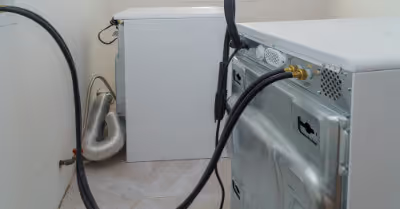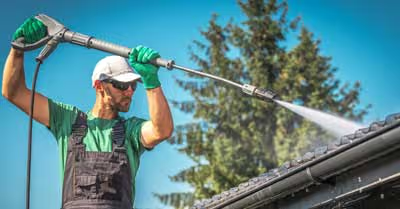Table of Contents
What Are Grub Worms?
Grub worms are the larvae of beetles that live in your soil where the eggs hatch. They are usually larvae from either June bugs or Japanese beetles. These beetles will spend a few weeks laying eggs in the soil and when they hatch you have hungry grub worms.
Grubs are thick, white or off-white worms. They will eat the roots of your grass and cause lots of lawn care headaches. As they grow, they will become beetles and lay more eggs just adding to the problem.
Signs of Grub Worm Infestation
As grub worms eat the roots of your grass, you will notice a few distressing problems in your lawn. There are some signs that you can look for to make sure you get to the root of the problem as soon as possible. This can help you prevent a severe infestation.
One thing to look out for is an increase in animal or bird activity. All sorts of animals love to eat grub worms, so if you have a lot in your yard the wildlife will be attracted to it. These birds and animals could do even more damage to your already suffering lawn.
As the grub worms eat the roots, your grass will begin to die. You will have dead spots in your grass. The soil where the grubs have been feasting will come up easier than it should because of damaged root systems. This problem is usually more present during the late Summer or Fall. When the rest of your lawn begins to become greener during the Spring, grub affected areas will remain brown.
You can identify a grub problem by digging into dead spots. If grub worms are the culprit, they will be easy to find. Dig up a square foot of your lawn and dig through to locate grub worms. If you locate more than 5 grub worms in a square foot of soil, you have an infestation that you need to take care of.
How to Get Rid of Grub Worms
There are few different methods to get rid of grub worms that you can try from chemical insecticides to traps to the introduction of a predator species.
Chemical Insecticide
There are different products available that can kill grub worms at any of their developmental stages. You can also look for curative products with either trichlorfon or carbaryl. You can buy products as either granule or liquid poison. These kill grub worms before they get too big and begin to damage your lawn.
If you choose granule insecticide, you can use a spreader to evenly apply it to your yard. Liquid pesticides often need to be diluted. Then you can put it into a pump sprayer and apply it around the lawn.
It is best to mow your lawn before applying the insecticide. It can also help to aerate the soil so that the poison gets into the dirt and reaches the grub worms and their habitat.
Neem Oil
This is a natural pesticide that comes from the Neem tree. Be sure to read the label for the correct dilution ratio. This is a great alternative to other insecticidal products and can also work as a preventative measure.
Neem oil can keep grubs from eating and laying eggs. This can break their development cycle so that the grub worm problem slowly dissolves. After dilution, you just have to spray it over and around the affected areas of your lawn. It is best to use a hose-end sprayer.
Nematodes
Nematodes are small roundworms that, like grub worms, like the soil underneath your lawn. They will attack the grubs and will destroy them from the inside. They only take a week at the most to work.
You can purchase nematodes at most home improvement stores. They have to be mixed with distilled water and applied with a sprayer. You have to apply them during the evening because sunlight and heat kill them. Apply a second treatment of nematodes two weeks after the first treatment.
Milky Spore Disease
Milky spore disease is an effective natural treatment for Japanese beetle larva. It is applied onto your lawn as a dust that infects the grass. When the grubs eat the grass, they get infected with the bacteria. This kills them and the population will reduce quickly.
You should use about a tablespoon every four feet. You don’t want to layer it over the whole yard and should never use a spreader or sprayer. After it is applied, lightly water the area.
Milky spore disease can prevent and control grub worms for years after application. It does take time to work, but it is a great long term solution to grub problems.
Birds
Birds love to eat grub worms. Sure it may seem counterintuitive to attract birds to your lawn since they can also damage it, but you will probably have to fix your lawn from grub damage anyway.
You can attract birds with bird feeders, houses, or baths. They will look for additional food throughout your yard. This is a good supplemental treatment option for severe grub worm infestations.
Beer Trap
This one is easy and effective for smaller grub populations. Just dig a hole and put a plastic bowl into it (tupperware tends to work well). Then fill it halfway with beer. Leave it overnight and in the morning you should see grubs (and other bugs) in the container.
How to Prevent Grub Worms
The best way to fight against grub worms is to prevent them in the first place. Plus, even if you had to eliminate an infestation, you don’t want them coming back. Try these methods to reduce the possibility that you will develop a grub worm problem.
Don’t Mow Too Often
Beetles like to lay their eggs so that they can reach the soil. Because of this, they don’t like laying their eggs in long grass. Of course you should still mow your lawn, but keeping it longer than you normally do can go a long way to prevent grub worms.
Overseeding
You should aim to overseed your lawn during the Spring or Fall so that the grass can get dense enough by Summer. This will cause beetles to look for additional spots to lay their eggs because they don’t like thick grass.
Fertilizer
Correct fertilization is a great way to improve your lawn and prevent infestations. You should fertilize in two stages to increase effectiveness. Do the initial fertilization during the Fall and then follow up with a second application of fertilizer in the Spring.
Water Habits
You have to water your lawn, but there are ways to water it without pleasing the grub worms. If you opt to use more water at once and do it less often, the grub worm eggs won’t have the constant water they need to hatch. This is a great way to prevent grub worms in a neighborhood that already has them.
Preventative Insecticides
You can purchase prevention insecticides made specifically for grub worms. These products work a little differently than other insecticide treatments. Neem oil can also be used to prevent grub worm problems.
You should apply preventative insecticides during the Summer because this is when the grub worms lay eggs and develop. Usually you should do this from the middle of July to the middle of August, but it could be different depending on the location.
How to Repair Lawn Damage Caused By Grub Worms
After you eliminate the grub worms, your lawn may be damaged badly. You could have damaged root systems or dead spots throughout your yard. It is best to remove any dead patches and then seeding new grass in the area. You can test for dead root systems by picking up the soil. If it comes up too easily, you should consider replacing the grass.
Before seeding the bare spots in your yard, use a rake to remove thatch and dead grass so that the seeds make it to the soil. If the spots are small enough and the root system is intact, you may be able to merely overseed without removing the existing grass. Another option is to use sod to patch up the bare spots around your yard.
Recent Articles
















